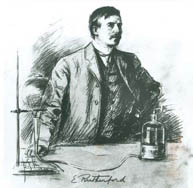McGill Research Facts
Turning Points 1901

Ernest Rutherford’s groundbreaking work on the nature of radioactivity may have been conducted in one of the best labs in the world, but his work was so far out on the edge that the Professor of Experimental Physics at McGill from 1898 until 1907 found he often had to construct his own devices to prove his theories.
The Rutherford Museum, in McGill’s Rutherford Physics Building, has many of the Nobel Laureate’s apparatus on display. In an experiment to describe the nature of alpha rays, Rutherford constructed the device shown here (in exploded view). Professor Jean Barrette, curator of the Rutherford collection, explains that this device was used by Rutherford to measure the deflection of alpha rays by electric fields, which, in combination with other experiments, allowed him to determine the charge-to-mass ratio of the alpha particles. He showed that this ratio is the same for alpha particles expelled from the different radio-elements and is equal to half that of the hydrogen ion. This work led to the revolutionary theory of radioactive transformation for which Rutherford is famous.
In an experiment to describe the nature of alpha rays, Rutherford constructed the device shown here (in exploded view)
A Contentious Collaboration

No one would ever accuse Ernest Rutherford of modesty. Told by a colleague that he was “riding a wave”—a turn-of-the-century term for being trendy—Rutherford famously replied, “Well, I made the wave.”
That confidence was in evidence heading into a debate organized between the young physicist and Frederick Soddy, a demonstrator in McGill’s chemistry department. The topic of discussion was Rutherford’s revolutionary theory that atoms were composed of smaller particles. He wrote to a colleague, “We are having a great discussion tomorrow in our local ‘Physical Society’ when we hope to demolish the Chemists.”

Soddy was not to be dismissed, eloquently attacking Rutherford’s ideas: “Possibly Professor Rutherford may be able to convince us that matter as known to him is really matter as known to us, or possibly he may admit that the world in which he deals is a new world demanding a chemistry and physics of its own, and in either case, I feel sure chemists will retain a belief and a reverence for atoms as concrete and permanent identities, if not immutable, certainly not yet transmuted.”
Rutherford was shaken by this attack, but Soddy was intrigued by the New Zealander’s ideas. The debate eventually led to one of the greatest scientific partnerships McGill has ever seen. Within months, the two scientists were engaged in what today would be called an interdisciplinary collaboration to describe the nature of the atom, each approaching the problem from their respective backgrounds.
Working in a brand-new lab funded by generous bequests from Sir William Macdonald, Rutherford and Soddy published nine important papers describing the nature of radioactivity, for which Rutherford was awarded the Nobel Prize in 1908. Soddy would also go on to win a Nobel Prize in 1921, for his investigations into the origin and nature of isotopes.
